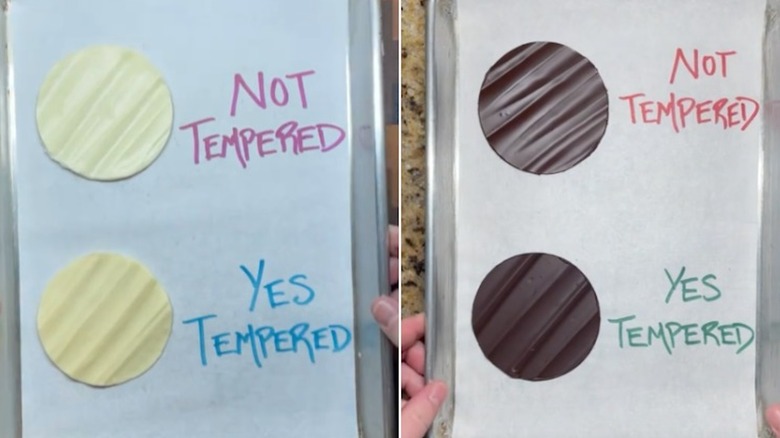Tempering White Vs Dark Chocolate: What's The Difference?
Tempering chocolate is a crucial step in chocolate making that involves carefully controlling its temperature to achieve the desired texture, shine, and snap. Whether working with white or dark chocolate, tempering ensures a smooth and glossy finish, extends shelf-life, prevents dullness and streaks, and guarantees that perfect chocolatey mouthfeel.
You may be surprised to learn there is a difference in technique depending on the color and style of your chocolate and it all comes down to temperature. Different chocolates have different levels of milk fats and cocoa butter, meaning they also have different melting points. White chocolate, for example, must cool to a lower temperature than dark chocolate when tempering.
To expertly temper white chocolate, Benjamin the Baker on TikTok suggests melting the chocolate in a bowl over barely simmering water until it reaches 104 degrees Fahrenheit. After that, remove from heat, mix in a bit more chocolate, and cool to between 84 and 86 degrees. For dark chocolate, the procedure is the same, but the mixture must reach 120 degrees Fahrenheit before removing it from the heat and then cooling to between 88 and 90 degrees.
The science behind tempering chocolate
Tempering chocolate is a precise process that is actually quite scientific. It involves manipulating the fat molecules in the cocoa butter into crystals to achieve the desired smooth, glossy finish and prevent pesky side effects like bloom or a product that melts in the hands. Heating chocolate breaks down the crystals, while slowly cooling it rebuilds them. The rebuilt crystals can arrange themselves in several forms, each producing a different end result. Too many of one type of crystal arrangement could mean a matte finish instead of glossy, while too many of another type of crystal arrangement could equate to chocolate that easily crumbles or melts.
Bloom occurs when the temperature fluctuations cause the cocoa butter to separate and rise to the surface, which creates an unsightly white or speckled film on the surface. A key way to avoid this is to ensure that the chocolate is gradually — rather than abruptly — cooled and reheated. Rapid temperature shifts speed up the separation of cocoa butter, resulting in bloom.
Tips and tricks for perfectly tempered chocolate — dark or white
Tempering chocolate is a lot of science, but it's not without a little bit of art, and there are some tried and true tips and tricks for getting it right every time. The agitation processis a necessity that contributes to the "snappiness" of the chocolate. Stirring the melted chocolate aggressively does two things: First, it helps the chocolate to melt evenly, and second, it stimulates the crystal growth.
You could also give the heating pad hack a try when tempering chocolate. Because the process involves keeping the product at a certain temperature (between 84 and 86 degrees for white chocolate and between 88 and 90 degrees for dark chocolate), a heating pad is the perfect assistant because you can essentially set it and forget it. Simply set your pad to the desired temperature and place your bowl of melted chocolate on top while you work with it.


